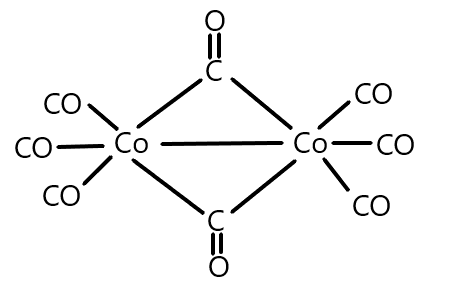Answer
397.2k+ views
Hint: As we know that oxidation state or oxidation number of the central metal atom/ion in a complex is the charge present on that atom/ ion if all the ligands are removed along with the electron pairs that are shared by the central atom/ion.
Complete step by step answer:
As we know that a ligand is that donor atom or molecule or anion which donates a pair of electrons to the metal atom/ion and hence they are also called as lewis bases.
We also know that complexes can be homoleptic and heteroleptic where homoleptic complexes are those which possess only one type of ligand and heteroleptic complexes are those that possess more than one type of ligands.
We are also aware of the oxidation state of the metal atom of the central atom which is given by the charge present on it.
Now, in the given molecule, we can see that the ligand present is the Carbonyl group which we know that is a neutral ligand and thus possesses zero charge. A total of eight carbonyl groups are present as ligands which will contribute a zero charge on the central atom that is cobalt because it is a homoleptic complex and no other ligand is present. And we can write the complex as: $[Co{(CO)_8}]$
Thus, from the above calculation the correct answer is (D).
Note: Always remember that carbonyl and cobalt seem similar but carbonyl contains $CO$ both in capital and it is a neutral ligand whereas $Co$ is a metal atom Cobalt. A neutral ligand is the one which does not contain any charge and electron pairs to donate. Along with $CO$, $N{H_3}$ and ${H_2}O$ are also neutral ligands. Halogens are considered anionic ligands and positively charged ligands are cationic ligands.
Complete step by step answer:
As we know that a ligand is that donor atom or molecule or anion which donates a pair of electrons to the metal atom/ion and hence they are also called as lewis bases.
We also know that complexes can be homoleptic and heteroleptic where homoleptic complexes are those which possess only one type of ligand and heteroleptic complexes are those that possess more than one type of ligands.
We are also aware of the oxidation state of the metal atom of the central atom which is given by the charge present on it.
Now, in the given molecule, we can see that the ligand present is the Carbonyl group which we know that is a neutral ligand and thus possesses zero charge. A total of eight carbonyl groups are present as ligands which will contribute a zero charge on the central atom that is cobalt because it is a homoleptic complex and no other ligand is present. And we can write the complex as: $[Co{(CO)_8}]$
Thus, from the above calculation the correct answer is (D).
Note: Always remember that carbonyl and cobalt seem similar but carbonyl contains $CO$ both in capital and it is a neutral ligand whereas $Co$ is a metal atom Cobalt. A neutral ligand is the one which does not contain any charge and electron pairs to donate. Along with $CO$, $N{H_3}$ and ${H_2}O$ are also neutral ligands. Halogens are considered anionic ligands and positively charged ligands are cationic ligands.
Recently Updated Pages
How many sigma and pi bonds are present in HCequiv class 11 chemistry CBSE

Why Are Noble Gases NonReactive class 11 chemistry CBSE

Let X and Y be the sets of all positive divisors of class 11 maths CBSE

Let x and y be 2 real numbers which satisfy the equations class 11 maths CBSE

Let x 4log 2sqrt 9k 1 + 7 and y dfrac132log 2sqrt5 class 11 maths CBSE

Let x22ax+b20 and x22bx+a20 be two equations Then the class 11 maths CBSE

Trending doubts
Fill the blanks with the suitable prepositions 1 The class 9 english CBSE

At which age domestication of animals started A Neolithic class 11 social science CBSE

Which are the Top 10 Largest Countries of the World?

Give 10 examples for herbs , shrubs , climbers , creepers

Difference between Prokaryotic cell and Eukaryotic class 11 biology CBSE

Difference Between Plant Cell and Animal Cell

Write a letter to the principal requesting him to grant class 10 english CBSE

Change the following sentences into negative and interrogative class 10 english CBSE

Fill in the blanks A 1 lakh ten thousand B 1 million class 9 maths CBSE




